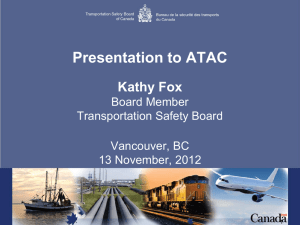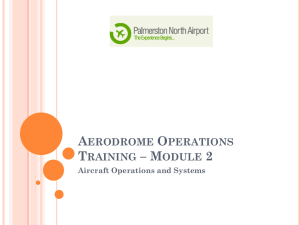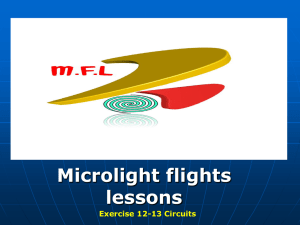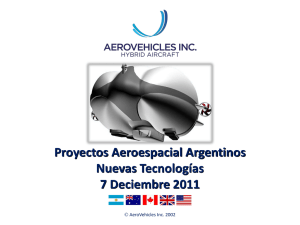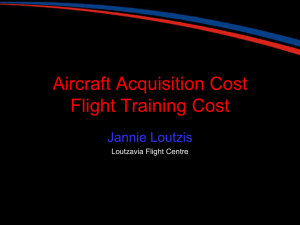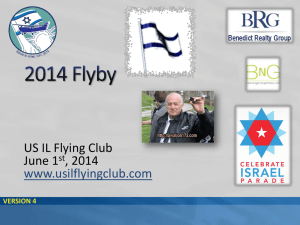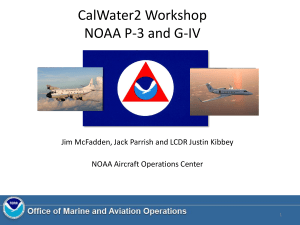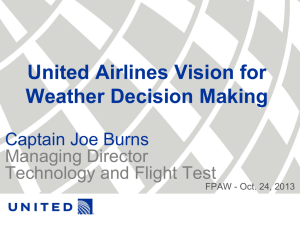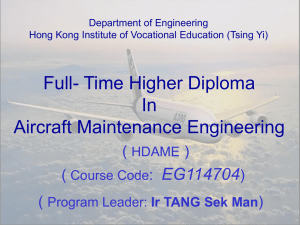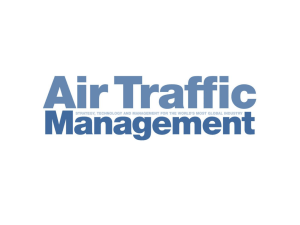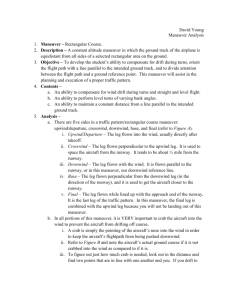A/C Handling Pt 6
advertisement
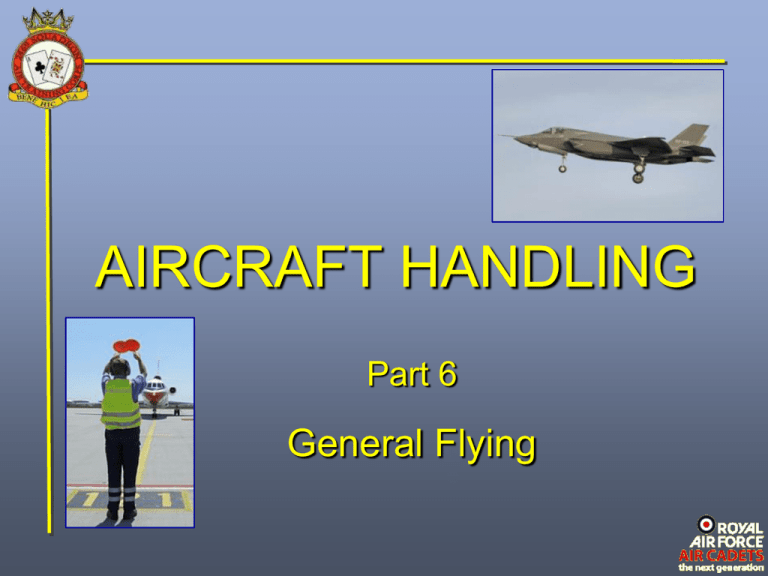
AIRCRAFT HANDLING Part 6 General Flying General Flying Before taxiing onto the runway a pilot must: 22 Complete his Vital Actions Receive permission from the controller Check that the approach is clear Test the flying controls for motion & response 22 AIRCRAFT SERVICING PLATFORM TAXI WAY General Flying Taxiing for take-off, the pilot stops at the Holding Point, a white line across the taxiway, 22 From here the pilot has a good view of the runway and final approach. 22 AIRCRAFT SERVICING PLATFORM TAXI WAY Holding Position & Holding Board General Flying 22 At the holding point, light aircraft pilots turn their aircraft about 45 degrees into wind, to complete their pre take-off checks. Wind 22 AIRCRAFT SERVICING PLATFORM TAXI WAY Holding Position & Holding Board General Flying Close to the runway holding position is the runway controller’s caravan. 22 His duty is to scrutinize aircraft about to take-off, checking for signs of danger such as loose panels, fuel leaks, oil leaks, and hydraulic leaks. Wind 22 AIRCRAFT SERVICING PLATFORM TAXI WAY Holding Position & Holding Board Take Offs Wind is a crucial factor affecting take-off, and take-off is normally made into the wind. 22 As the aircraft lines up, any headwind along the runway will serve to shorten the take-off run. Wind 22 AIRCRAFT SERVICING PLATFORM TAXI WAY Take Offs 22 A 20 knot headwind along the runway will be indicated as 20 kts on the aircraft’s airspeed indicator (ASI). 20kt wind 22 AIRCRAFT SERVICING PLATFORM TAXI WAY Take Offs Wind velocity produces a steeper angle of climb after becoming airborne. G/S = 80kts IAS = 80kts No wind G/S = 0kts IAS = 0kts 500ft 1 minute G/S = 60kts IAS = 80kts 20kt wind 500ft 1 minute G/S = 0kts IAS = 20kts Take Offs The length of the take-off run depends on: All-up weight More weight means more lift, which means more speed gained by increasing run up. Amount of flap Higher co-efficient of lift enables the aircraft to take off at a lower Indicated Air Speed (IAS) Engine power Greater thrust means faster take off. Runway gradient Uphill = less acceleration = longer take-off. Take Offs The length of the take-off run depends on: Runway surface Moisture, mud, grass, pot holes, all increase friction, decrease acceleration & increase take off. Air temperature High air temp reduces the air density reducing lift at a given airspeed. Thrust can be reduced by 4%- 5% per 5ºC above 15ºC. Airfield elevation Reduced air density at altitude increases the length of take-off. The Circuit Aircraft may be taking off and completing the circuit to practice landings. To reduce congestion and risk of collision, aircraft should enter the circuit in a planned and systematic manner. Take off Finals 18 00 ‘Dead’ side Wind The Circuit Downwind leg The Circuit The pilot approaches the airfield, looking-out for other aircraft. After clearance, he will join overhead at a minimum height of 1000 ft above circuit height. 18 00 ‘Dead’ side Wind The Circuit Downwind leg The Circuit The pilot lets down on the ‘dead’ side in a wide curve, to reach the start of the downwind leg at circuit height. 18 00 ‘Dead’ side Wind The Circuit Downwind leg The Circuit Pre-landing checks are completed on the DOWNWIND leg 18 00 ‘Dead’ side Wind The Circuit Downwind leg The Circuit On approach, flaps are lowered to give a steeper descent for a set speed, a lower stalling speed and a better view over the nose of the aircraft. ‘Dead’ side 18 00 Finals Wind The Circuit Downwind leg The Circuit It must be remembered on approach that when the throttle is opened, a jet engine does not respond as quickly as a piston engine. ‘Dead’ side 18 00 Finals Wind The Circuit Downwind leg The Landing To land the aircraft the pilot changes the descending path of the approach to one level with, and just above, the ground. This is known as the ‘round out’. Runway The Landing The aircraft is then flown parallel to the ground, with increasing angle of attack and falling airspeed, until touchdown. This is known as the ‘hold-off’ or ‘float’. Runway The Landing Landing a nose-wheel aircraft, the nose-wheel should be held off the ground until after the main wheels touch. Runway The Landing With tail wheel aircraft, all three wheels should touch the ground together – a three point touchdown. Runway Check of Understanding What do light aircraft normally do at the runway holding point? Turn downwind Shut down their engines Turn into the wind Stop heading along the taxiway Check of Understanding If an aircraft is positioned ready for take-off and the headwind is 30 kts, what will be indicated on the ASI? Zero 60 kts 20 kts 30 kts Check of Understanding What is the opposite side of an aerodrome's downwind side known as? Dead side Upwind side Finals side Approach side Check of Understanding When the throttle of a jet engine is opened the engine responds: Slower than a piston engine The same as a piston engine Faster than a piston engine Slower if the temperature is higher Check of Understanding In the landing phase, What is the point called where the pilot changes the descending path of the approach to one level with, and just above, the ground is called: The hold-up The hold-off The round-out The round-up Check of Understanding In the landing phase what is the period in which the aircraft is flown parallel to the ground with increasing angle of attack and falling airspeed to the touchdown point called? The touch point or float The hold-up or float The float point or touch The hold-off or float Check of Understanding When landing a nose-wheel aircraft when should the nose-wheel touch the ground? Behind the main wheels Before the main wheels With the main wheels After the main wheels AIRCRAFT HANDLING End of Presentation

